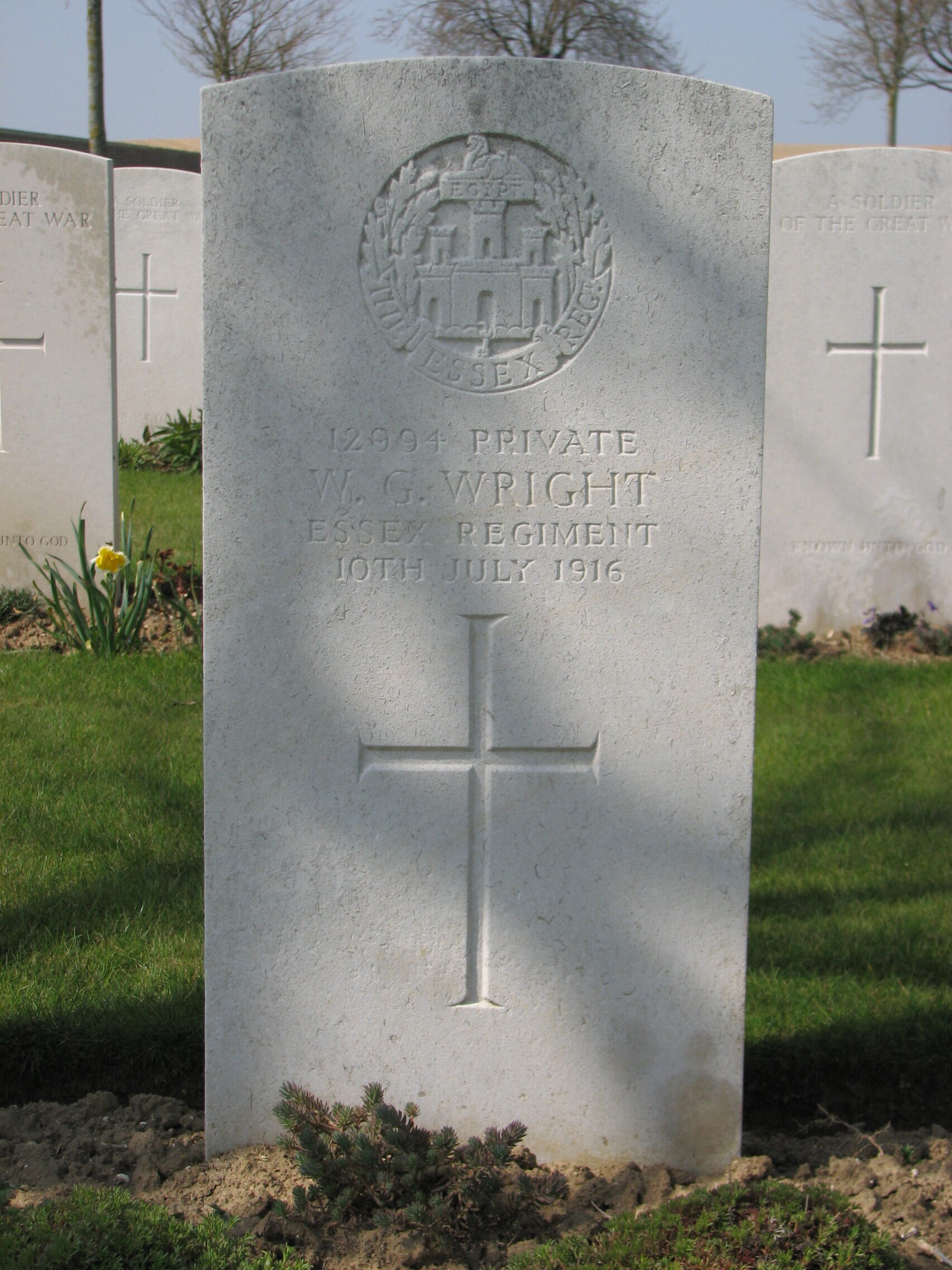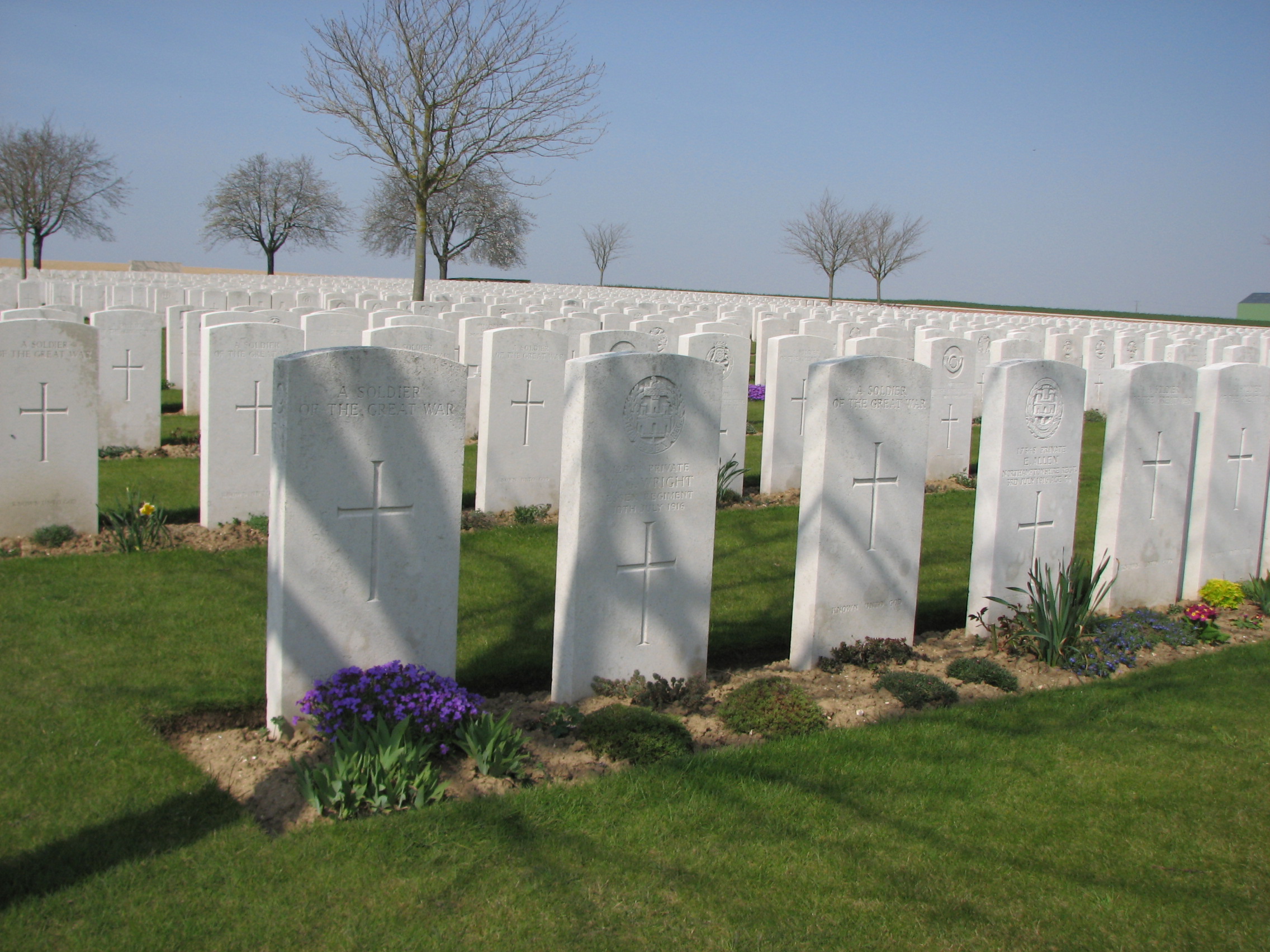William G. Wright (1892 - 1916)
William volunteered to join the Essex Regiment in early September 1914. He served for ten months with their 9th Battalion on the Western Front, until his death during the Battle of the Somme.
- 72
- Died in the Great War
- 51.980827, 1.031893
Details
| Name: | William George Wright |
| Service: | British Army |
| Unit: | 9th Battalion, Essex Regiment |
| Regimental Number: | 12994 |
| Rank: | Private |
| Date of Death: | 10th July 1916 |
| Age: | 24 |
| Buried: | Plot IX, Row N, Grave 2, Ovillers Military Cemetery, near Albert, France |
The Battle of the Somme raged for over four and a half months during the summer and autumn of 1916, at a cost to the British of over 420,000 casualties. 1 The National Army Museum states that the British Empire suffered 420,000 casualties during the course of the Battle of the Somme, the French 200,000 and the that German losses were at least 450,000 killed and wounded. The Imperial War Museum agrees the British casualties, but puts the German casualties at 500,000; with no mention of French casualties. Casualties refers to those killed, wounded and missing. The first of the ten East Bergholt men to die in the Battle was William George Wright.
Family Background and Early Life
William George Wright was born in East Bergholt on 5th March 1892, the second son of William Walter Wright (who was usually just called Walter) and his wife Julia.
Walter Wright was a Bergholt lad born and bred, who worked on farms almost all of his life, initially as a Labourer and later as a Horseman. Julia Wright (nee Taylor) was originally from Great Clacton, and prior to her marriage in 1883 had been a servant at the East Bergholt Rectory. Together, they had 13 children, of whom only 7 survived infancy.
At the time of William’s birth, the family were living on East End Road (now called the Mile Straight) though at some point in the late 1890’s they moved to Puttick’s Lane. 2 The 1901 Census shows the family living on Cutler’s Lane, near to Rookery Farm, however the name of Putticks Lane does not appear on the 1901 Census for East Bergholt at all. No other record refers to the family living on Cutler’s Lane. If they did live on Cutler’s Lane at all it was only for a relatively short period at some point between 1896 and 1903. Alternatively, it seems more likely that the Wright family lived on Putticks Lane throughout, but it was recorded as Cutler’s Lane on the 1901 Census.
William attended the village school at Burnt Oak Corner, between September 1896 and February 1906. After leaving school – like a large number of men in the area at that time – William found employment as a Farm Labourer.
Tragedy struck the family in late 1909, when William’s mother died at the age of 45. At some point between April 1911 and September 1915, Walter and those of his family who still lived with him, moved to Gandish Road. Whether this move occurred before or after William joined the Army is not known.
Joins the Army
William volunteered to join the Essex Regiment in early September 1914, at the time when thousands were doing so in response to Lord Kitchener’s call. After undergoing basic training, he disembarked in France on 24th August 1915, and was sent initially to a Base Depot for further training and instruction. Just over two weeks later, on 10th September –as part of a reinforcement draft of 30 men – William joined the Regiment’s 9th Battalion. He was allocated to “A Company”.
The 9th was one of the Essex Regiment’s battalions raised specifically for the war, and initially were made up almost entirely of those men who had volunteered to join up in 1914 and early 1915. The Battalion had been in France since 30th May 1915 as part of the 12th (Eastern) Division. At the time that William joined the Battalion they were in the trenches near Ploegsteert Wood, north of Armentieres.
The Battle of Loos
At the end of September, the Battalion moved south to where they would take part in the British offensive which had started on the 25th of the month. This was the British Expeditionary Force’s largest offensive of the war to date and took place along a six mile front between the town of Lens and La Bassee.
Known to history as the Battle of Loos, the offensive is perhaps now best remembered now for the first use of poison gas by the British. There was some success in breaking the German line on the first day near the villages of Loos and Hulluch, however this success could not be exploited and the remainder of the Battle bogged down into attritional warfare for little gain.
The 9th Essex were involved in the later stages of the Battle during October, and subsequently spent a large part of the next seven months in the Loos Sector of the front. In late April 1916, along with the rest of their Division, they left the Loos Sector, and commenced a two month period of instruction and training. This was in preparation for “the Big Push” being planned to take place in the summer on the Somme.
The Battle of the Somme
The Battle of the Somme commenced on 1st July 1916, with a massive attack by both the British and the French. The attacks were unsuccessful in many places, and the British suffered over 57,000 casualties including nearly 19,000 dead on that one day.
The 9th Essex were not involved in the fighting on that day, but in the evening they took over part of the line from one of the units which had suffered severely. The part of the line that they took over was the Support trenches opposite the village of Ovillers, which had been one of the failed objectives of the first day of the offensive.
The Battalion suffered heavy losses on the 3rd July, when they were part of another unsuccessful attack to capture Ovillers; they lost 398 Officers and men, either killed, wounded or missing. Ironically, due to a mistake, part of the Battalion did assist in the final capture of the neighbouring village of La Boisselle.
After two days out of the line, late in the evening of 7th/8th July the Battalion (by then consisting of 18 Officers and 487 Other Ranks) returned to the trenches, taking over positions at the edge of the ruins of Ovillers.
At 3 a.m. the Battalion used hand grenades to force the Germans out of 200 yards of the enemy front line, but owing to a strong counter attack they were only able to hold on to 100 yards of their gains. They were then subject to shelling at frequent intervals by both High Explosive and shrapnel.
At noon the Battalion advanced their positions to the old German third line in Ovillers. The Germans again opened a heavy bombardment on the British line and also made a small attack which was promptly dispersed by the Battalion’s rifle fire.
The Battalion were relieved at 12.30 in the morning of 9th July, having suffered 88 casualties over the previous 26 hours, including 12 killed, 65 wounded and 11 missing.
Officially, William is recorded as having been killed in action on 10th July 1916. However, this is almost certainly an error and he was most likely killed in the fighting on the 8th – probably being one of the 11 men listed as “missing”. 3 On 10th July 1916, the Battalion were “out of the line” and training in the village of Varennes approximately 6 miles from the front. The Battalion War Diary does not record any deaths on that day, which in the circumstances would be extremely unusual.
Unless the man’s death was actually witnessed or the body found and identified immediately, then it was not uncommon for a soldier’s date of death to be recorded as being on the date when the first Roll Call was taken after the Battalion came out of the line. William’s original burial site is also further evidence that he was killed in the fighting on the 8th.
Postscript
The ruins of the village of Ovillers were not finally captured by the British until 16th July 1916.
William’s body was found and buried close to where he fell. After the war, when the authorities chose to establish permanent cemeteries, his body was exhumed and buried very close by in the Ovillers Military Cemetery. The cemetery now contains the graves of 3,440 Commonwealth servicemen, of whom 2,475 are not identified.
Copyright © Mark Ashmore, 2024
- 72
- Died in the Great War
- 51.980827, 1.031893




